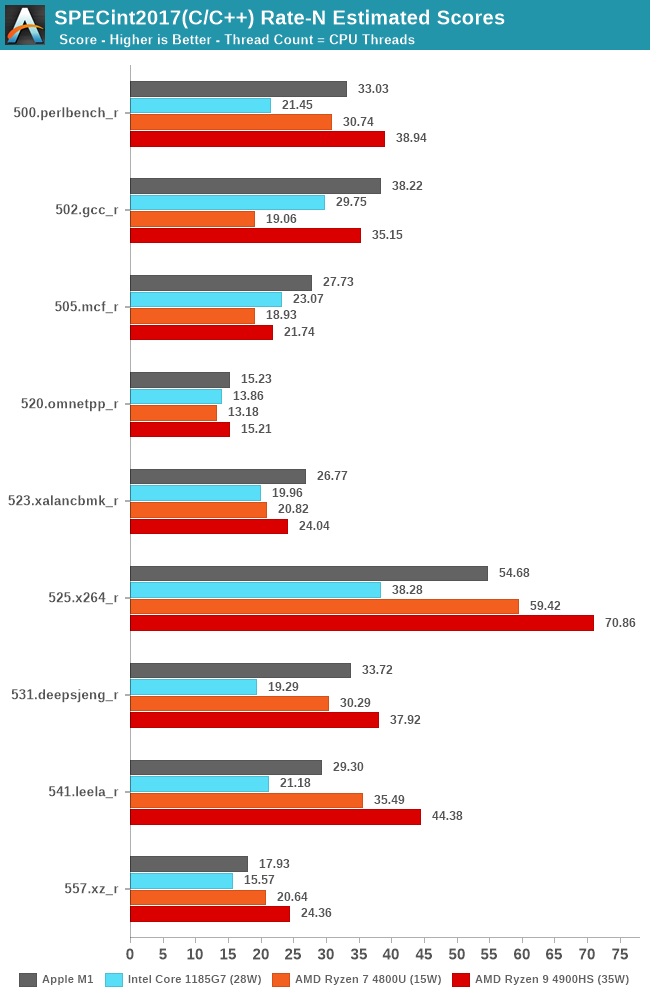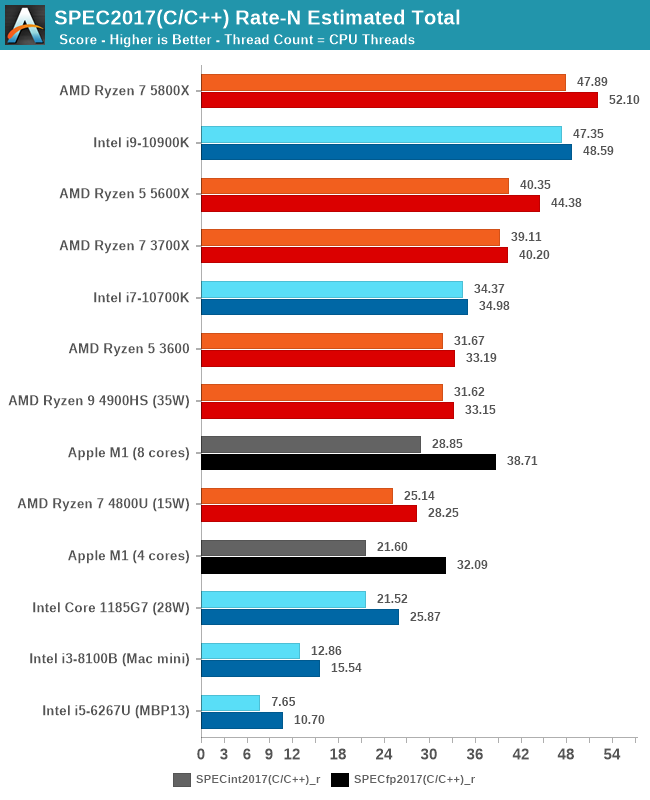The 2020 Mac Mini Unleashed: Putting Apple Silicon M1 To The Test
by Andrei Frumusanu on November 17, 2020 9:00 AM ESTSPEC2017 - Multi-Core Performance
While we knew that the Apple M1 would do extremely well in single-threaded performance, the design’s strengths are also in its power-efficiency which should directly translate to exceptionally good multi-threaded performance in power limited designs. We noted that although Apple doesn’t really publish any TDP figure, we estimate that the M1 here in the Mac mini behaves like a 20-24W TDP chip.
We’re including Intel’s newest Tiger Lake system with an i7-1185G7 at 28W, an AMD Ryzen 7 4800U at 15W, and a Ryzen 9 4900HS at 35W as comparison points. It’s to be noted that the actual power consumption of these devices should exceed that of their advertised TDPs, as it doesn’t account for DRAM or VRMs.

In SPECint2017 rate, the Apple M1 battles with AMD’s chipsets, with the results differing depending on the workload, sometimes winning, sometimes losing.

In the fp2017 rate results, we see similar results, with the Apple M1 battling it out with AMD’s higher-end laptop chip, able to beat the lower TDP part and clearly stay ahead of Intel’s design.

In the overall multi-core scores, the Apple M1 is extremely impressive. On integer workloads, it still seems that AMD’s more recent Renoir-based designs beat the M1 in performance, but only in the integer workloads and at a notably higher TDP and power consumption.
Apple’s lead against Intel’s Tiger Lake SoC at 28W here is indisputable, and shows the reason as to why Apple chose to abandon their long-term silicon partner of 15 years. The M1 not only beats the best Intel has to offer in this market-segment, but does so at less power.
I also included multi-threaded scores of the M1 when ignoring the 4 efficiency cores of the system. Here although it’s an “8-core” design, the heterogeneous nature of the CPUs means that performance is lop-sided towards the big cores. That doesn’t mean that the efficiency cores are absolutely weak: Using them still increases total throughput by 20-33%, depending on the workload, favouring compute-heavy tasks.
Overall, Apple doesn’t just deliver a viable silicon alternative to AMD and Intel, but actually something that’s well outperforms them both in absolute performance as well as power efficiency. Naturally, in higher power-level, higher-core count systems, the M1 can’t keep up to AMD and Intel designs, but that’s something Apple likely will want to address with subsequent designs in that category over the next 2 years.










682 Comments
View All Comments
Ppietra - Tuesday, November 24, 2020 - link
No,with this:
https://twitter.com/i/web/status/13287773335122780...
anandtech author’s twitter account, something that for some reason you have refused to read!
amazing how you cannot distinguish between processor power consumption and machine power consumption.
Nicon0s - Monday, November 30, 2020 - link
"?? I gave you the Cinebench results. I gave the actual battery capacity, I gave how much it drained when running Cinebench and in what time interval - it is all in the videos!"LoL, you only linked to unprofessional, amateurish video. Nobody in their right mind would try to suggest that a video like that is conclusive in terms of how efficient a 4800U chip is.
Nicon0s - Monday, November 30, 2020 - link
"Didn’t measure the power draw? Really?Yeas, really. You have so clear perception problems.
Nicon0s - Monday, November 30, 2020 - link
Exactly, quite a flawed way of comparing processor efficiency, also he didn't even test the laptops until the end to see is the power is lost progressively on all laptops.Nicon0s - Monday, November 30, 2020 - link
"Sorry, but no!"WoW, some apple fanboys here are really dense.
Also recommending an amator youtuber, that was cringey.
Pacinamac - Saturday, November 21, 2020 - link
I am smiling know who had huge involvement in the development of M1...You all know who I am talking about...
Anand. :)
GeoffreyA - Sunday, November 22, 2020 - link
My brother and I were talking about the same thing a week or two ago. I reckon he's been giving Apple advice/guidance on this whole matter. Someone who can see the whole forest in one fell swoop, but understands the wood and bark as well. "The Enemy is moving with their armies of Zen, while the Coves of Sunny languish in the Lakes of Ice, under spell of the Willow Lady. The hero Rocket is detained in the Lost Fields of 14. Now, now is the time to strike with the M1, smiting down the Free Peoples of PC-earth, while the wind speaketh the language of ARM." ;)GeoffreyA - Sunday, November 22, 2020 - link
On a serious note, I think he's been giving the CPU team a bit of design advice too.Anyhow, it would be great to hear an update from him, even if it were just a personal one, telling us how he's doing.
Tomatotech - Sunday, November 29, 2020 - link
He can’t. A lot of contracts specify absolutely no talking to media (which would include Anandtech) without corporate approval. For someone coming from a journalist background, even running a personal blog might raise eyebrows as it is ‘public media’. I don’t like it, but many non-Apple companies are sensitive and paranoid about this kind of thing. I can only imagine it 100x worse at Apple.Tomatotech - Sunday, November 29, 2020 - link
To add, even if he got corporate approval for a screened interview / statement, it almost certainly couldn’t be with AnandTech. Apple / others might see that as unduly favouring one media outlet because he has personal history with AnandTech. The choice of outlet has to be done by someone else, choosing for professional reason, and fitting in with Apple’s media strategy.